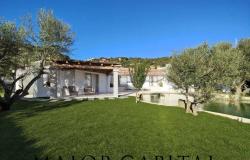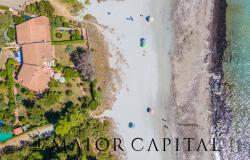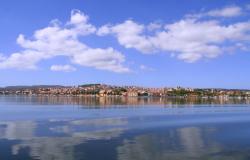A smattering of taupe outcrops rises above teal-hued wavelets in Nora, a peninsula in Southern Sardinia. At first, this looks bizarre because the rocks that lie underwater are a very different colour—a rich ochre encrusted by the vivid green of thriving marine flora, which is what gives the sea its unusual teal hue. But a closer look reveals a much greater surprise. The taupe outcrops are not rocks at all—they are the remnants of an ancient Roman wall.
Over the centuries, the Mediterranean Sea has eaten away a good part of the Southern Sardinian coastline, burying many of Nora’s walls, mosaics and amphorae under a crystalline blanket. But the waters that ultimately spelled the city’s end were also the reason for its foundation.
The Nora promontory is caught between the sea and a turquoise lagoon, and this is what attracted a sequence of invading mariners. Legend has it that the hero Norax—son of the god Hermes and the nymph Erythia, according to the Greeks—landed here with a group of Iberians of Phoenician origin. He fell in love with the place so much that he decided to live there and founded a city—Nora.
The truth is likely rather more prosaic. The Phoenicians traded extensively along the Mediterranean coast, and often built warehouses on safe shores. Nora has a natural harbour that is sheltered from the winds even today, making it an obvious choice for Phoenician ships. What started as a trading compound then evolved into a settlement, and later a city.
 The sea also moulded Nora’s history, bringing in Carthaginian invaders by 509BC, then the Romans in 238BC. And it was under Rome that the city really came into its own, becoming a busy port that linked the empire’s capital with Spain, Greece, Africa and Southern France.
The sea also moulded Nora’s history, bringing in Carthaginian invaders by 509BC, then the Romans in 238BC. And it was under Rome that the city really came into its own, becoming a busy port that linked the empire’s capital with Spain, Greece, Africa and Southern France.
The Roman legions, and the engineers and builders that invariably followed in the soldiers’ footsteps, obliterated the former Phoenician settlement, reshaping it to suit the conquerors’ taste. Up went fora, theatres and sewers, the quintessential trio of government, pleasure and practicality that marked all Roman architecture. And of course the baths—Nora had no less than four, testament to its wealth and importance.
Today, gentle waves lap the seaside baths, and the squawking of seagulls and cormorants diving for fish has replaced the humming buzz of the calidarium and frigidarium of yore.
But Rome still lives in every stone of every building—the perfect geometry of the mosaics in the central baths, the thick walls of Aesculapius’ temples, the graceful columns of a patrician’s villa soaring over a sapphire bay. It breathes in the amphitheatre, where yearning poetry verses and gentle guitar notes have continued to fill the juniper-scented midnight air well beyond the Roman era, loud against a giant, silent moon and the soft whispers of a silvery surf. It even survives underwater, in the amphorae, caves and shipwreck relics that pepper the lagoon.
The spirit of Roman Nora remains unvanquished, even though the sea eventually killed the city. It was a slow death, which happened long before the waters closed in on walls and houses. Riding the Mediterranean waves came the Vandals, then hordes of Saracen pirates who sacked and burned Nora’s buildings. The locals slowly moved to the safer inland villages and the by the 7th century AD the city had been abandoned.
In the 16th century, the Spaniards, who ruled Sardinia at the time, built a chain of forts to guard Nora’s coastline from the pirates, but those too fell into disrepair over time. Only the cormorants and the seagulls remained sentinels over the ruins and the waters—as they still do five hundred years later.
How to visit Nora
You can tour the archaeological site on foot or hire a boat and view it from the sea; in summer, you can also attend poetry events at the still active Roman theatre—but not this year, as ongoing excavation work caused the annual Notte dei Poeti festival to be moved elsewhere. Low-impact snorkelling and canoeing tours of the lagoon are available through local conservation body Centro di Educazione Ambientale (www.lagunadinora.it).












